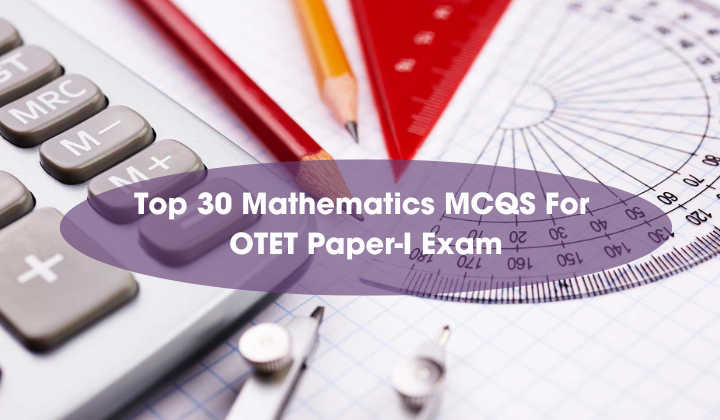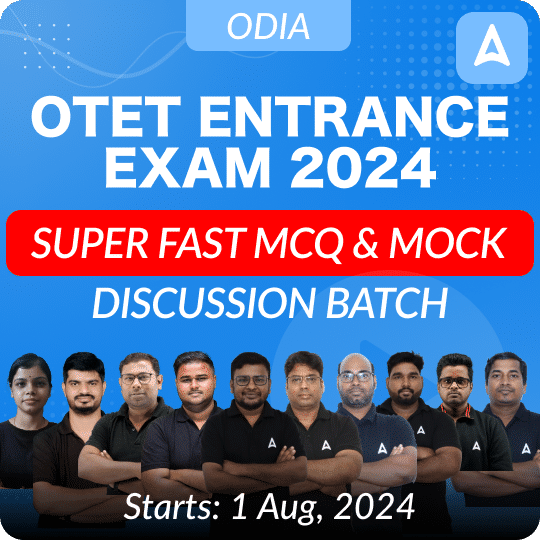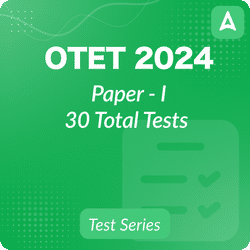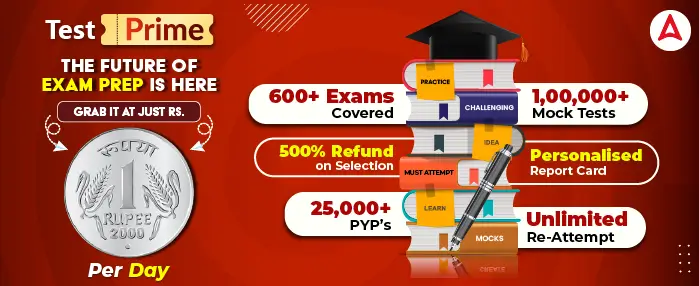Preparing for the Odisha Teacher Eligibility Test (OTET) Paper-I requires a strong grasp of mathematics concepts relevant to the secondary school curriculum. Here, we present a curated selection of 30 multiple-choice questions (MCQs) covering various topics in mathematics. These questions are designed to help you assess and reinforce your understanding in preparation for the exam.
Top 30 Mathematics MCQS For OTET Paper-I Exam
- The effective measure for cultivating learner’s sensitivity towards learning of Mathematics is:
(a) to relate the subject matter to the learner’s field of experience
(b) to enquire about the previously acquired knowledge in relation to what is being taught
(c) to make learners acquainted with the application of concepts, more preferably, in daily life situations
(d) All of the above
Ans: (d) All of the above - Priya is good at solving mathematical problems. Which type of multiple intelligence in her is high?
(a) Linguistic intelligence
(b) Logical intelligence
(c) Interpersonal intelligence
(d) Psycho-motor intelligence
Ans: (b) Logical intelligence - A teacher has to teach the subject of volume and surface area of a cylinder and a cone. The skill-based objective of teaching will be:
(a) the pupil will be able to distinguish between features of a cylinder and a cone
(b) the pupil will be able to draw the figure of a cylinder and a cone
(c) the pupil will be able to recall the formulae for calculating the volume and surface area of a cylinder and cone
(d) the pupil will be able to find the height of a cone when a given cylinder is melted into a cone
Ans: (a) the pupil will be able to distinguish between features of a cylinder and a cone - “Mathematics is the mirror of civilization and culture”. Who said this statement?
(a) Bacon
(b) Hogben
(c) Locke
(d) Dutton
Ans: (b) Hogben - Mathematics is the science of:
(a) Space
(b) Education
(c) Calculations
(d) Life of human
Ans: (a) Space - What is the importance of Mathematics at the Primary Level?
(a) Cultural
(b) Social
(c) Religious
(d) Mental
Ans: (d) Mental - The difference between an achievement test and a diagnostic test is of:
(a) Objectives
(b) Nature
(c) Level of difficulty
(d) None of these
Ans: (a) Objectives - Most of the use of Mathematics is done in the activities of human life. This is:
(a) Cultural
(b) Psychological
(c) Social
(d) Economical
Ans: (b) Psychological - Evaluation is closely related to:
(a) Content
(b) Evaluation strategies
(c) Objectives
(d) Process of learning
Ans: (c) Objectives - The most effective teaching aid is:
(a) Non-projected
(b) Direct experience
(c) Projected
(d) None of these
Ans: (b) Direct experience - Find the area of the given rectangle.
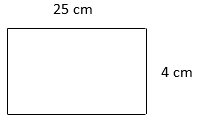
a) 16 cm²
b) 100 cm²
c) 625 cm²
d) 50 cm²
Answer: b
Explanation: Area of rectangle
= l × b = 25 × 4
= 100 cm². - Calculate the area of the given figure.

a) 150 cm²
b) 125 cm²
c) 225 cm²
d) 100 cm²
Answer: c
Explanation: Area of square = (s)² = (15)² = 225 cm². - Find the area of the given figure.
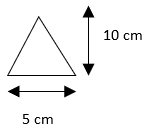
a) 20 cm²
b) 50 cm²
c) 15 cm²
d) 25 cm²
Answer: d
Explanation: Area of triangle =
1/2 × b × h
= 1/2 × 10 × 5
= 25 cm². - What is the area of the given circle? (π = 3.14)
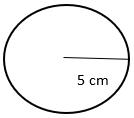
a) 78.5 cm²
b) 78 cm²
c) 76.5 cm²
d) 77 cm²
Answer: a
Explanation: Area of circle = π(r)² = 3.14(5)²
= 78.5 cm². - Find the area of the given parallelogram.
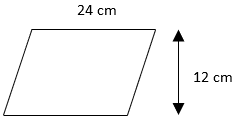
a) 142 cm²
b) 284 cm²
c) 144 cm²
d) 288 cm²
Answer: d
Explanation: Area of parallelogram = b × h
= 12 × 24
= 288 cm². - What is the total angle at the center of a pie chart?
a) 360°
b) 320°
c) 180°
d) 90°
Answer: a
Explanation: Pie chart is basically a circle. Total angle at the center of a circle is 360°. The central angle of the sectors will be a fraction of 360°. - Below is the pie graph showing sales of different items in the first quarter of the year.
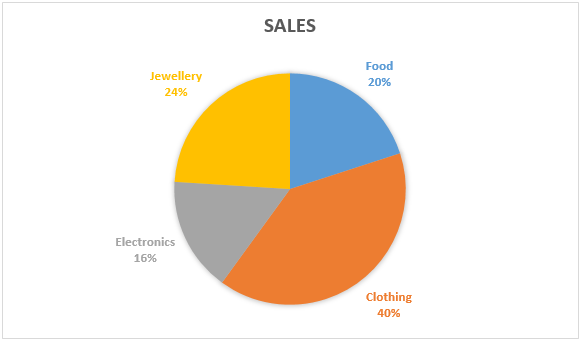
Which item has the highest sales?
a) Food
b) Clothing
c) Electronics
d) Jewellery
Answer: b
Explanation: Pie graph shows the relation between the whole and its parts. Sales of clothing is 40% of total sales of the store, which is higher than the sales of the other three items. - Below is the pie graph showing sales of different items in the first quarter of the year.

Which item has the lowest sales?
a) Food
b) Clothing
c) Electronics
d) Jewellery
Answer: c
Explanation: Pie graph shows the relation between the whole and its parts. Sales of electronics is 16% of total sales of the store, which is lower than the sales of the other three items. - Below is the pie graph showing sales of different items in the first quarter of the year.

If the total sales of the company are Rs 600000, how much are the sales of food in Rs.?
a) 96000
b) 120000
c) 240000
d) 144000
Answer: b
Explanation: The pie graph shows the relation between the whole and its parts. 20% of the company’s sales is from the food department. Total sales of the company is Rs. 600000. Thus, sales of the food department is Rs. 120000. - Below is the pie graph showing sales of different items in the first quarter of the year.

If the total sales of the company are Rs 1000000, how much are the sales of electronics in Rs.?
a) 160000
b) 200000
c) 400000
d) 240000
Answer: a
Explanation: The pie graph shows the relation between the whole and its parts. 16% of the company’s sales is from the electronics department. Total sales of the company is Rs. 1000000. Thus, sales of the electronics department is Rs. 160000. - If we add two triangular numbers, what would be the result?
a) Square
b) Square Root
c) Cube
d) Cube Root
Answer: a
Explanation: If we add two triangular numbers, the sum would be a perfect square. For example, 1 and 3 are triangular numbers, and their sum is 4, which is a perfect square. - There are _____ non-square numbers between the square of 5 and 6.
a) 11
b) 12
c) 13
d) 10
Answer: d
Explanation: The non-square numbers between the square of 5 and 6 (i.e., 25 and 36) are 26, 27, 28, 29, 30, 31, 32, 33, 34, and 35, totaling 10 numbers. - If we add the first n odd numbers, we get ______.
a) n²
b) 2n
c) 3n
d) n
Answer: a
Explanation: When we add the first n odd numbers, the result is n². For example, the first 5 odd numbers are 1, 3, 5, 7, and 9. Their sum is 25, which is the square of 5. - How can one express 143 in terms of squares?
a) 12² – 1
b) 144 – 1
c) 13² – 1
d) 14² + 1
Answer: a
Explanation: The correct expression is 12² – 1, which equals 143 in the form of squares. - If the square of 11 is 121, what is the square of 111?
a) 121
b) 12321
c) 1234321
d) 123321
Answer: b
Explanation: The square of numbers containing only the digit 1 follows a pattern: 11² = 121, 111² = 12321. This pattern can be used to calculate squares of similar numbers. - By simplifying (3)1/3 * (3)2/3, we get __________
a) (3)2/9
b) (3)-1/9
c) 9
d) 3
Answer: d
Explanation: According to laws of exponents, am an = a(m+n)
Applying that rule here, (3)1/3 * (3)2/3 = 3(1/3+2/3)
= 3(1+2)/3
= 33/3
= 31 = 3. - By simplifying (7)2/5 * (7)3/4, we get __________
a) (7)6/20
b) 7
c) (7)23/20
d) (7)-7/20
Answer: c
Explanation: According to laws of exponents, am an = a(m+n)
Applying that rule here, (7)2/5 * (7)3/4 = (7)(2/5+3/4)
= (7)((2*4)+(5*3))/(5*4)
= (7)(8+15)/20
= (7)23/20.
Note: Join free Sanfoundry classes at Telegram or Youtube - By simplifying (9)1/4 * (9)7/4, we get __________
a) 81
b) 9
c) 3
d) 27
Answer: a
Explanation: According to laws of exponents, am an = a(m+n)
Applying that rule here, (9)1/4 * (9)7/4 = (9)(1+7)/4
= (9)8/4
= (9)2
= 81. - By simplifying (5)3/4/(5)1/4, we get __________
a) (5)1/4
b) (5)3/16
c) 5–√3
d) 5–√2
Answer: d
Explanation: According to laws of exponents, am/an = am-n
Applying that rule here, (5)3/4/(5)1/4 = (5)(3/4-1/4)
= (5)(3-1)/4
= (5)2/4
= (5)1/2
= 5–√2. - By simplifying (4)9/(4)3, we get __________
a) 427
b) 46
c) 412
d) 43
Answer: b
Explanation: According to laws of exponents, am/an = am-n
Applying that rule here, (4)9/(4)3 = 4(9-3)
= 46.

